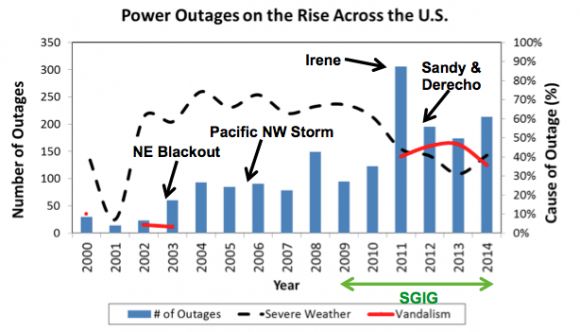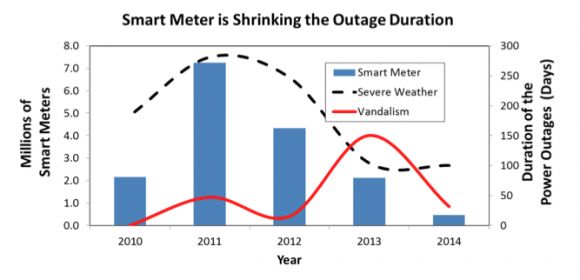The picture of the U.S. energy infrastructure is far from rosy. An analysis of the electricity outage data from the Department of Energy shows that outages are on the rise.
In fact, the average number of outages doubles every five years, largely because of extreme weather events. Events such as the Northeast blackout (2003), Pacific Northwest storm (2006), Hurricane Irene (2011), Hurricane Sandy (2012), and the East Coast derecho (2012) caused major outages impacting large swaths of the country.
Another notable trend is the increased occurrence of vandalism events, which have been on the rise since 2010.

The number of electrical outages in the U.S. continues to double every 5 years. The blue vertical bars indicate the number of outages. The black-dashed and red-solid lines indicate the cause of the outage as a percentage of the total number of outages.
In recent years, government programs such as the Smart Grid Investment Grant (SGIG) -- which spanned the period 2009-2014 -- have placed a renewed emphasis on modernizing the electrical infrastructure.
The SGIG program consisted of 99 cost-shared projects, involving more than 200 electric utilities and participating organizations. With $8 billion of joint investment between the U.S. government and grant recipients, SGIG rapidly deployed a wide array of smart-grid technologies. As a result, over 15 million smart meters and 1,200 phasor measurement units were deployed, in addition to 19,000 units of distribution technology (e.g., automated switches) and an assortment of customer systems (e.g., in-home displays).
But what difference did it make? What is the impact of smart-grid technology deployment on the resilience of the U.S. electricity infrastructure?
Based on available SGIG data, one way to view the impact is to look at the duration of the electrical outage before and after SGIG. In the second figure below, we compare SGIG’s smart-meter deployment against the total duration of the outages as experienced across the U.S. (with causes cited as severe weather and vandalism).
Although the number of outages has increased since 2010, we can see that outage duration is decreasing.
Indeed, there is strong correlation between the deployments of smart meters and the decrease of outage duration for events caused by severe weather. The duration of the severe-weather outages tapers downward after 2011, after the deployment of 14 million smart meters and 19,000 units of distribution equipment (e.g., automated switches and capacitors) by 2012.
This strong correlation implies that smart grid technological advancements have made the grid more resilient to severe weather; however, there is insufficient data to conclude a direct cause-and-effect relationship. The correlation between the duration from vandalism and smart-grid technologies is less clear.

The deployment of smart-grid technologies, as represented in this figure via smart meters, is strongly correlated with the decreased outage duration due to severe weather.
This analysis only scratches the surface of quantifying the benefits of smart grid technology. More direct measurement and analysis on increased grid resiliency resulting from smart-grid technology deployment is needed. Further research into the cause of outages, factors that impact outage duration, and the operational benefits of smart technology -- such as reductions in operations and maintenance costs -- will need to be measured, analyzed and communicated to the community at large.
Quantitative nonoperational benefits also need to be identified and measured. These include the reduction in carbon emissions from reducing transmission and distribution losses, or faster recovery time from an outage that enables businesses to continue to operate.
These metrics must be identified, measured and monetized -- helping justify the business case for smart-grid investments.
Utilities around the globe are investing billions of dollars to deploy smart-grid technologies. Successful utilities will not be those that invest the most, but those that invest the smartest.
Successful smart-grid deployments also depend on wide public acceptance; consumers and other stakeholders will need to recognize the impact of smart-grid technologies. Identifying, measuring and communicating the benefits of our smarter grid is the next major task. There are positive signs. But coming up with these accurate measurements is more daunting than the hardware deployment itself.
***
Dr. Chen is chief strategy officer at Energetics, Inc.



